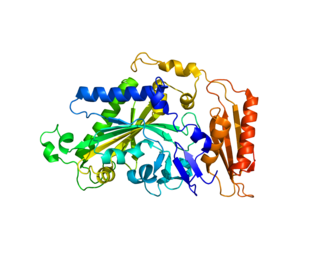Hereditary spastic paraplegia (HSP) is a group of inherited diseases whose main feature is a progressive gait disorder. The disease presents with progressive stiffness (spasticity) and contraction in the lower limbs. HSP is also known as hereditary spastic paraparesis, familial spastic paraplegia, French settlement disease, Strumpell disease, or Strumpell-Lorrain disease. The symptoms are a result of dysfunction of long axons in the spinal cord. The affected cells are the primary motor neurons; therefore, the disease is an upper motor neuron disease. HSP is not a form of cerebral palsy even though it physically may appear and behave much the same as spastic diplegia. The origin of HSP is different from cerebral palsy. Despite this, some of the same anti-spasticity medications used in spastic cerebral palsy are sometimes used to treat HSP symptoms.

Proteolipid protein 1 (PLP1) is a form of myelin proteolipid protein (PLP). Mutations in PLP1 are associated with Pelizaeus–Merzbacher disease. It is a 4 transmembrane domain protein which is proposed to bind other copies of itself on the extracellular side of the membrane. In a myelin sheath, as the layers of myelin wraps come together, PLP will bind itself and tightly hold the cellular membranes together.

The human gene SPAST codes for the microtubule-severing protein of the same name, commonly known as spastin.
Atlastin-1, is a protein that in humans is encoded by the ATL1 gene.

Seipin is a protein that in humans is encoded by the BSCL2 gene.

McKusick–Kaufman/Bardet–Biedl syndromes putative chaperonin is a protein that in humans is encoded by the MKKS gene.

Paraplegin is a protein that in humans is encoded by the SPG7 gene located on chromosome 16.

Kinesin family member 5A is a protein that in humans is encoded by the KIF5A gene. It is part of the kinesin family of motor proteins.

Non-imprinted in Prader-Willi/Angelman syndrome region protein 1 is a protein that in humans is encoded by the NIPA1 gene. This gene encodes a potential transmembrane protein which functions either as a receptor or transporter molecule, possibly as a magnesium transporter. This protein is thought to play a role in nervous system development and maintenance. Alternative splice variants have been described, but their biological nature has not been determined. Mutations in this gene have been associated with the human genetic disease autosomal dominant spastic paraplegia 6.

KIAA0196 is a human gene. The product is a protein that is a component of the WASH complex, which regulates actin assembly on intracellular vesicles. Mutations in KIAA0196 are implicated in some forms of hereditary spastic paraplegia.

Kinesin-like protein KIF1C is a protein that in humans is encoded by the KIF1C gene. Kif1C is a fast, plus-end directed microtubule motor. It takes processive 8nm steps along microtubules and can generate forces of up to 5 pN. Kif1C transports α5β1-integrins in human cells. Kif1C has been shown to be non-essential in mouse with other proteins able to perform the same function. However, mutations in KIF1C lead to spastic paraplegia and cerebellar dysfunction in humans. These mutations usually result in a total loss of the protein or (partial) loss of function, such as significant lower force output.

Maspardin is a protein that in humans is encoded by the SPG21 gene.

Receptor expression-enhancing protein 1 is a protein that in humans is encoded by the REEP1 gene.
Warburg Micro syndrome (WARBM), also known as Spastic Paraplegia 69 (SPG69) or RAB18 Deficiency, is a rare autosomal recessive genetic disorder characterized by congenital cataract, hypotonia, spastic diplegia, intellectual or developmental disability, microcephaly, microcornea, optic atrophy, and hypogenitalism.

Phenylalanyl-tRNA synthetase, mitochondrial (FARS2) is an enzyme that in humans is encoded by the FARS2 gene. This protein encoded by FARS2 localizes to the mitochondrion and plays a role in mitochondrial protein translation. Mutations in this gene have been associated with combined oxidative phosphorylation deficiency 14, also known as Alpers encephalopathy, as well as spastic paraplegia 77 and infantile-onset epilepsy and cytochrome c oxidase deficiency.

Spatacsin is a protein that in humans is encoded by the SPG11 gene.

Zinc finger, FYVE domain containing 26 is a protein that in humans is encoded by the ZFYVE26 gene.
Spastic paraplegia 15 (SPG15) is a form of hereditary spastic paraplegia that commonly becomes apparent during childhood or adolescence. The disease is caused by mutations within the ZFYVE26 gene - also known as the SPG15 gene - and is passed down in an autosomal recessive manner.

AP-5 complex subunit beta (AP5B1) is a protein that in humans is encoded by the AP5B1 gene.

AP-5 complex subunit sigma (AP5S1) is a protein that in humans is encoded by the AP5S1 gene.

















